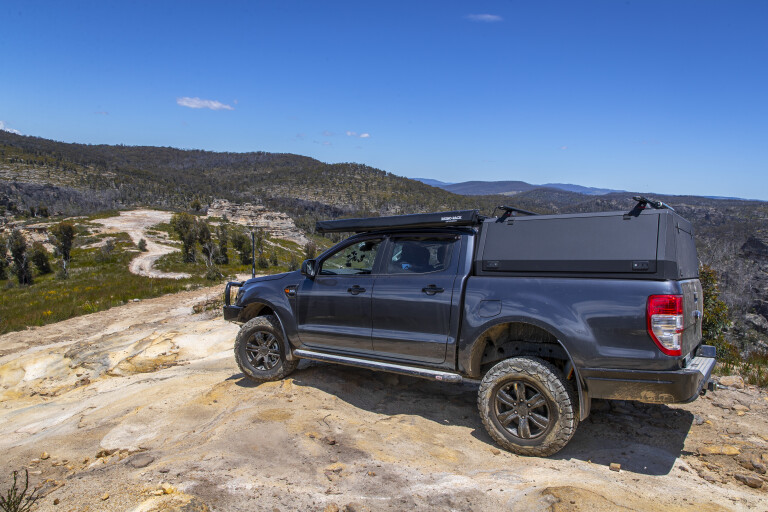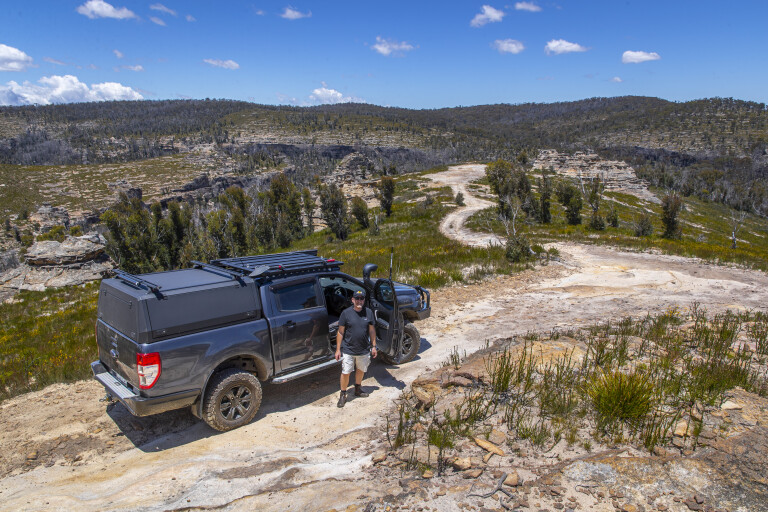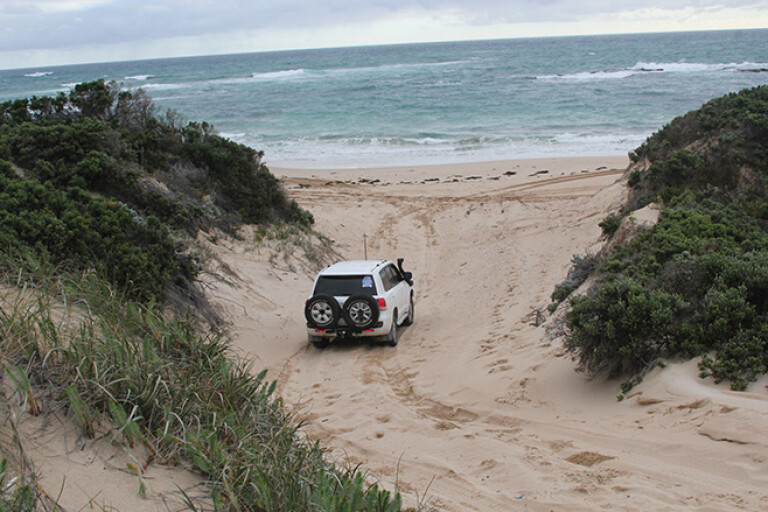
As the saying goes, “what goes up, must come down” and this is obviously true of four-wheel driving; if you drive up a hill, eventually you’re going to have to come back down. And depending on the conditions, driving downhill can be a lot scarier than driving uphill.
As the vehicle speed picks up on descent, your instinct will be to apply the brakes to slow down, but in particularly steep and slippery conditions this can result in the front wheels locking, which will lead to a loss of steering control … and you definitely don’t want this to happen. Even if the vehicle is equipped with an anti-lock braking system (ABS), stomping on the brake pedal can be next to useless if there’s not much traction available.

There are a few critical things to be aware of before attempting a steep off-road descent. Firstly, take a good look at the terrain ahead, so you are aware of what to expect when driving down the hill and what you need to avoid.
You also need to understand how your vehicle works, what features it is equipped with that will aid your descent, and how to best set it up for the terrain ahead.
The terrain
In any off-road driving situation, it is important to have a handle on the terrain you’re about to drive. Sometimes you can judge this from the driver’s seat, by looking out the windows and by feeling how the vehicle responds to steering, accelerator and brake inputs; but sometimes the best way to see what’s coming up is to get out of the vehicle and walk the track first.
In the case of descents, you will need to ascertain how steep the hill is and what condition the track is in, looking out for off-camber sections, undulations and washouts, as well as obstacles such as rocks, holes, muddy sections, vegetation and tree roots.

You should also look for potential hazards off to the sides of the track, such as rocks or trees that may cause a problem if you stray from the track, or dangerous drop-offs that need to be avoided. While you’re walking the track, feel around with your feet to gauge how much traction is available.
You should also keep an eye out for run-off areas and suitable anchor points in case you need to use recovery gear to belay the vehicle safely down any treacherous sections.
If you have a capable person travelling with you who can act as a spotter to direct you from outside the vehicle, find a good place for them to stand so they are visible to you but will not be in danger if you lose vehicle control. Make sure the driver and the spotter understand the hand signals that will be used, and if radios are available they should communicate with each other via in-vehicle and handheld UHFs.
The vehicle
The more intimate the knowledge you have of your vehicle, the easier you will find it to drive in off-road situations. In the case of steep descents there are certain vehicle attributes to be aware of and to know how to use, such as how to lock hubs (where fitted) and engage four-wheel drive in part-time 4x4 vehicles, or how to ensure the centre diff is locked in full-time 4x4 vehicles.
Most 4x4s with genuine off-road capability will also have low-range gearing, and you will need to know how to engage this before starting a descent. In old-school 4x4s, low range is mechanically selected via a lever, whereas many modern vehicles will have an electronic dial or a button to select low range.

No matter what type your vehicle is equipped with, make sure you know how to use it and ensure that low range is selected when you need it to be; there’s usually a light on the dash to indicate this.
There are a few 4x4 vehicles with genuine off-road capability that don’t have low-range gearing, such as some Volkswagen Amarok models. These will usually have a super-low first gear ratio, sometimes called a crawler gear, and this should be selected for steep descents.
Other vehicle features that can aid safe descents include electronic traction aids such as ABS, traction control, hill descent control and selectable drive modes, while mechanically locking diffs are also beneficial.

On some vehicles, even the handbrake (or park brake) can be a useful tool for steep descents, but this is of greatest benefit on vehicles where the handbrake is a transmission-mounted drum set-up, so when applied it operates on all four wheels.
An effective handbrake that only operates on the rear wheels can also be helpful, as it can retard progress without affecting steering, but such a set-up doesn’t really offer a lot of braking effect on steep descents, as most of the vehicle weight is over the front axle.
You should also be aware of the vehicle’s ground clearance and have an idea of how much suspension travel it has when tackling steep descents, as you will have a better understanding of what type of terrain you’ll be able to drive over before grounding the underside or running out of wheel travel.
Of course, this only comes with experience; the more you drive the vehicle in different off-road situations, the easier it will become, and soon even the gnarliest descents will become second nature. But let’s not get ahead of ourselves…
Tyre pressures
In every 4X4 Australia ‘How To’ instalment, we have discussed the importance of setting the correct tyre pressures to suit different terrain types, and driving down steep off-road descents is no different. Lowering tyre pressures for off-road terrain lengthens the tyre footprint and provides more traction, and good traction is critically important on steep descents.

Dropping air pressure also allows the tyres to more easily flex as they drive over uneven terrain such as sharp rocks and tree roots, which minimises the chance of tyre damage. If your vehicle is equipped with tough Light Truck (LT) tyres, you will be able to lower tyre pressures more than if it’s fitted with Passenger (P) construction tyres.
As a general rule, if your usual road pressures are around 35psi, and you’re running LT tyres on your vehicle, you can drop pressures to around 22psi for rough off-road tracks. For more detail on tyre pressures, see the 4X4 Australia’s ‘How to select correct tyre pressures’ guide.
Ready to roll ... almost
Once you’ve examined the descent and you’re happy to proceed, you need to set up your vehicle for the task at hand.
Make sure your tyre pressures are set and your hubs are locked (if fitted), and then engage low range and select first gear, no matter whether your vehicle has a manual gearbox or an automatic transmission. If you find that first gear is too slow for the descent, you can always upshift to second, but if you start off in too-high a gear and the speed starts getting away from you, you won’t always be able to shift back down to first.
If the descent is quite undulating and there’s a chance you will exceed the vehicle’s suspension travel, engage the rear locker if fitted. This will ensure both rear wheels will rotate at the same speed even if one of them is lifted off the ground, which will give you more vehicle control on the descent. It will be much more difficult to steer the vehicle if you engage the front diff lock, so try to avoid doing so unless you become stuck.

If your vehicle is equipped with selectable drive modes such as ‘sand’, ‘rocks’ or ‘mud and ruts’, select the mode that best describes the terrain. These modes tailor the vehicle’s throttle response, traction control levels and ABS sensitivity to best suit the terrain. If you have height-adjustable suspension, select the highest mode for rocky or undulating descents where you think you’ll need all the ground clearance you can muster.
What about Hill Descent Control? The better HDC systems on the market allow you to adjust vehicle speed using the up and down cruise control buttons, usually in 1km/h increments down to as low as 1km/h, but even these systems are not suited to all steep descents.
HDC systems rely on the vehicle’s brakes to keep speed in check, and although they can do this without the wheels locking up, on very long descents, such as those you might find in alpine regions, using the brakes will generate a lot of heat. This heat not only affects the brakes themselves but also other mechanical components such as wheel hubs and axle seals.
Bear in mind that you’ll occasionally find water crossings at the bottom of steep descents; if you do, give your vehicle’s mechanical components time to cool down before plunging into cold water. If you don’t, water can get sucked in through the seals, contaminating the oil in the engine, gearbox, transfer case and diffs.
Beginning the descent
Once you’ve set the vehicle up to tackle the descent, gradually release the brakes, drive slowly over the edge, and let gravity do the work for you. Unless the hill is extremely steep and the vehicle’s low-range gearing isn’t keeping speed in check, try to avoid applying the brakes.
On a long descent, you might feel the speed is too slow in low-range first, but only shift up to second or third if you know you’ll be able to safely slow down again if you need to, such as for a tricky section of track up ahead. As you descend the hill, you will need to adjust the speed to suit the changing track conditions.
If the track is muddy, make sure any vehicles ahead have cleared the descent before you set off. There will often be visible wheel tracks in muddy terrain; if you can see that these tracks lead to where you want to go, and you think you have enough available ground clearance, drive in the tracks rather than trying to fight them. If the tracks are too deep or they spear off into the scrub, you’ll want to straddle them as much as possible, and then try to drive out of them if you slide in.

On a rocky descent with reasonable traction, you’ll probably need to use the brakes to ease over big drop-offs without damaging the vehicle, but don’t stab at the pedal, gently apply brake pressure to avoid wheel lock-up.
If driving a manual 4x4 vehicle and you’ve slowed down so much you’re going stall the engine, don’t worry; it’s better to stall than to push on the clutch pedal, because once that clutch is disengaged the vehicle can begin to roll down the hill and you will have little control over it. If you do stall, again don’t push on the clutch pedal; simply turn the key in low first with the clutch pedal out and the vehicle should start driving down the hill again.
On steep descents, you won’t always be able to see what’s directly ahead such as when driving over obstacles or cresting drainage mounds, so keep your speed in check in case there’s a steep drop on the other side. If you have a spotter and can stop before a tricky section of track, ask them to get out and direct you.
If you are able to and want to stop on a steep descent for any reason, get on the UHF and let others in your party know what you’re up to so following vehicles don’t proceed until the track is clear.
Descending vehicles generally have right of way when they encounter oncoming vehicles climbing a track, but if there’s room and you are able to safely pull up, let oncoming vehicles go past.
Finally, try to keep the vehicle pointed down the hill at all times and try to avoid driving across steep tracks or you could roll your vehicle.
Sand dunes
Driving down steep sand dunes is very different to any other kind of descent. Sand dunes have a shallow windward side and a steep leeward side, and the latter, sometimes called the slip face, can be up to 34 degrees steep.
The method of safely descending a steep slip face is to slowly drive over the edge in low-range first or second gear and then let gravity do the work. You won’t need to apply braking pressure as the soft sand on the slip face will arrest vehicle speed, so stay off the brake pedal and point the vehicle directly down the face of the dune.

As you approach the base of the dune, get ready to accelerate, as this is where the sand is often at its softest, and the last thing you want to do after you’ve pulled off an impressive dune descent is get stuck at the bottom.
Look out for abrupt drop-offs or step-ups though, as these could see the front of your rig digging into the sand if you hit them too fast.
If you get into strife
The most difficult aspect of steep descents is keeping your speed in check, especially in slippery mud. If you start off nice and slow, you will have a better chance of maintaining a steady speed on the descent, but if you start too fast it can be nigh impossible to slow down once your speed has picked up.
Whatever you do, try to avoid applying brake pressure, because if you lock up the front wheels, not only will you be unable to slow down, you also won’t be able to steer. Although it might seem counter-intuitive, sometimes the only way to regain steering on slippery downhill sections is to get on the accelerator and drive your way out. Once you have regained steering control, ease off the accelerator as soon as possible and try not to get on the brakes until there’s more traction available.
If you find yourself stopped halfway down a slippery, muddy hill, and you’re terrified by the prospect of completing the next part of the descent, try dropping your tyre pressures some more. I once dropped pressures to about 5psi to get out of a super slippery situation and was amazed at the traction it afforded me; but make sure you re-inflate the tyres as soon as it’s safe to do so to avoid damaging them.
Job complete
Once you’ve made a safe descent, don’t forget to return vehicle settings to suit the terrain ahead, and reinflate your tyres if necessary. If you heard any bangs and crashes on the way down, take a look around and under your rig to inspect for damage. Oh, and if you left your spotter halfway up the hill behind you, don’t leave without them.
Recovery gear
If you end up in a situation where you have no steering control or you have inadvertently driven off the track, you’ll need to turn to your recovery gear.
On muddy hills a shovel can be used to dig artificial wheel tracks that can help you steer the vehicle, and on rocky tracks recovery boards can be used to bolster sections of track that might need building up.

If you’re in a convoy, sometimes the safest way to descend a steep bit of track hill is to belay off another vehicle using a winch. This can be slow and laborious, but it’s better to take your time than damage the vehicle. Winch-extension straps can be invaluable in such scenarios.
Always carry a complete recovery kit when driving off-road and make sure you know how to use it. A winch should be complemented by a winch-extension strap, a tree-trunk protector, snatch blocks and shackles.
Make sure you have a long-handle shovel and recovery boards, and if travelling in convoy a snatch strap or kinetic recovery rope … and always wear protective gloves when using recovery gear.
Do
- Study the terrain ahead and walk the track if necessary
- Know your vehicle systems and how to best use them
- Adjust tyre pressures to suit the terrain
- Use low-range gearing to keep your speed in check
- Adjust vehicle speed to match the terrain
Don't
- Apply brakes and lock up the steering wheels
- Descend the hill until vehicles have cleared the track
- Stop on the track without warning others in your convoy
- Disengage the clutch on a steep descent
- Leave your spotter behind in the bush

COMMENTS